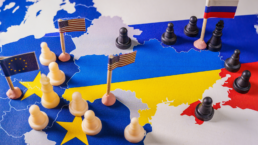The Ukrainian conflict saw the start of an economic war waged via sanctions on Russia by the West. But this second war isn’t going well.
By Patrick Cockburn, CounterPunch
When President Vladimir Putin invaded Ukraine in February, he began two very different wars. One was a military conflict in which the Russian armed forces have suffered repeated defeats, from the failure of the initial invasion to the successes of the Ukrainian counter-offensive.

But the Ukrainian conflict also saw the start of an economic war waged against Russia by the West whose outcome is far more uncertain. The US, UK, EU and their allies have sought to impose a tight economic siege on Russia, focusing primarily on its oil and gas exports, to weaken it and compel it to give up its assault on Ukraine.
This second war, in contrast to the situation on the battlefield, has not been going well and the West suffered a serious setback this week when the Opec+ group, which includes Russia, decided to cut its crude exports by two million barrels a day in order to force up prices. The decision came despite intense lobbying of Saudi Arabia by the US where President Joe Biden is desperate to prevent the price Americans pay for petrol at the pump going up just before the midterm congressional elections in November. Reacting furiously to the news, the White House spokesperson Karine Jean-Pierre said that it was “clear” that Opec+ was “aligning with Russia”.
Embarrassing Aspect Of Oil Sanctions
The desire among Democrats to keep oil prices low is so intense that they have led to a little-noticed and – from the point of view of the US and many of its Nato allies – embarrassing aspect of oil sanctions on Russia. It is only because the sanctions have largely failed that the price of benchmark Brent crude fell 24 per cent from $123 a barrel in mid-June to $93.50 a barrel earlier this week.
Recent Posts
The Rage Of Billionaires And The Frenzy To Stop Zohran Mamdani From Becoming New York’s Mayor
June 30, 2025
Take Action Now The constellation of forces now regrouping with a vengeance includes titans of Wall Street, enormous real estate interests,…
It’s Not Just The Cities. Extreme Heat Is A Growing Threat To Rural America.
June 28, 2025
Take Action Now The urban heat island sits in a rural heat ocean.By Umair Irfan, Vox Summer has officially begun with a blast of scorching…
Mamdani’s Massive Victory Should Show Democrats Where The Party’s Future Lies
June 27, 2025
Take Action Now NYC mayoral candidate Zohran Mamdani has thrown the drowning Democratic Party a life vest. Will its leaders use it?By Sam…
India Walton’s Advice For Zohran Mamdani
June 26, 2025
Take Action Now “I think that for him, the race ’til November needs to be staying on message—we can’t start to water it down…




